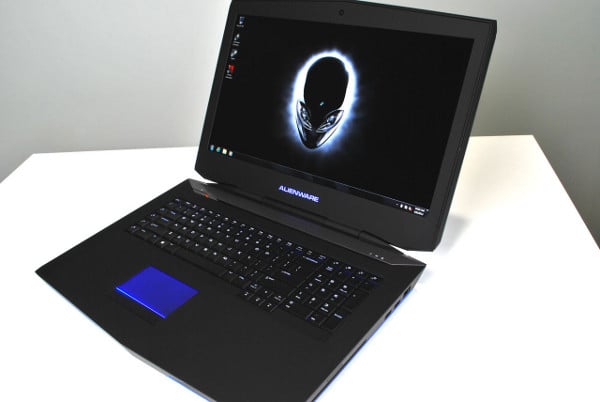Alienware 17: AMD's R9 M290X Goes Mobile
Introduction and Specifications
NVIDIA holds the lion's share of the market in mobile graphics hardware, but it's not the only competitor. When Alienware asked if we'd be interested in looking at a notebook based on AMD's top-end R9 M290X in a single-GPU configuration, we agreed. This system is based on exactly the same hardware and chassis as the Alienware 18-inch model that we reviewed last fall, but it's somewhat more modest hardware whacks a full $2000 off the price.
Unlike the massive system we reviewed last time around, this rig's performance aims at what, on a desktop, would be considered a midrange GPU with a moderately high-end CPU core. The high-speed storage, plentiful RAM, and high-DPI screen (for a PC, anyway) are places where Alienware (or a hypothetical buyer) could cut costs to bring the $2500 down further. Unlike conventional laptop shopping, which is virtually defined by compromise at any price point, Alienware took care to build this system without any weak spots.
That said, we do need to talk about the R9 M290X...
AMD's "New" GPU:
The GPU at the heart of this system is a part AMD calls the R9 M290X -- but you're probably more familiar with it as the Radeon HD 7970M, aka the Radeon HD 8970M. AMD has chosen to take a somewhat different path than NVIDIA when it comes to its mobile products. Since 2012, NVIDIA has launched three different laptop variants of its 1536-core GK104 GPU -- the GTX 680MX, the GTX 770M, and the just-launched GTX 880M. The only thing that differentiates these products is the clock speed -- the GTX 680MX was clocked at 720MHz, the GTX 880M is clocked at 954MHz with a higher boost clock on top of it.
Update: It turns out that the GTX 680MX is not a mobile chip, even though Nvidia calls it a notebook GPU.This GPU was actually only used as a one-off in the 27-inch iMac. The first "full" implementation of the GK104 architecture in mobile was therefore the GTX 780M.
AMD, in contrast, has kept exactly the same speeds and feeds for its parts for two years running -- the AMD R9 M290X is the same as the Radeon HD8970M, which is the same as the Radeon HD 7970M.
This kind of rebranding is common in the industry, but in this case, AMD has split the feature sets on its high-end hardware. The R9 M290X doesn't support AMD's TrueAudio technology or the company's XDMA solution for superior Crossfire scaling. Customers who read about AMD's Hawaii-class GPUs and buy the mobile parts expecting the same feature sets won't get them. That's something we thought you should all be made aware of from the get go.
Unlike the massive system we reviewed last time around, this rig's performance aims at what, on a desktop, would be considered a midrange GPU with a moderately high-end CPU core. The high-speed storage, plentiful RAM, and high-DPI screen (for a PC, anyway) are places where Alienware (or a hypothetical buyer) could cut costs to bring the $2500 down further. Unlike conventional laptop shopping, which is virtually defined by compromise at any price point, Alienware took care to build this system without any weak spots.
That said, we do need to talk about the R9 M290X...
|
| Model: CPU: GPU: Display: Memory: Storage: Optical Drive: Connectivity: Battery: Support: Extras: Price: |
Alienware 17 Intel Core i7-4700MQ (6MB cache, 2.4GHz Base, 3.4GHz Turbo Boost) 1x AMD Radeon R9 M290X (4GB GDDR5) 17.3" WLED FHD (1920 X 1080) Anti-Glare Display 16GB dual-channel DDR3L-1600MHz 256GB mSATA SSD Boost 1TB SATA 3Gbps (5400 RPM) HDD Slot-Loading Dual Layer Blu-ray Reader (BDROM, DVDRW, CD-RW) Broadcom 4352 802.11 ac 2x2 and Bluetooth 4.0 8-cell Lithium Ion (86 w Hr) 1 Year Alienware Basic Support Alienware Command Center 3.0 $2499 (as configured), lower cost builds available |
AMD's "New" GPU:
The GPU at the heart of this system is a part AMD calls the R9 M290X -- but you're probably more familiar with it as the Radeon HD 7970M, aka the Radeon HD 8970M. AMD has chosen to take a somewhat different path than NVIDIA when it comes to its mobile products. Since 2012, NVIDIA has launched three different laptop variants of its 1536-core GK104 GPU -- the GTX 680MX, the GTX 770M, and the just-launched GTX 880M. The only thing that differentiates these products is the clock speed -- the GTX 680MX was clocked at 720MHz, the GTX 880M is clocked at 954MHz with a higher boost clock on top of it.
Update: It turns out that the GTX 680MX is not a mobile chip, even though Nvidia calls it a notebook GPU.This GPU was actually only used as a one-off in the 27-inch iMac. The first "full" implementation of the GK104 architecture in mobile was therefore the GTX 780M.
AMD, in contrast, has kept exactly the same speeds and feeds for its parts for two years running -- the AMD R9 M290X is the same as the Radeon HD8970M, which is the same as the Radeon HD 7970M.
This kind of rebranding is common in the industry, but in this case, AMD has split the feature sets on its high-end hardware. The R9 M290X doesn't support AMD's TrueAudio technology or the company's XDMA solution for superior Crossfire scaling. Customers who read about AMD's Hawaii-class GPUs and buy the mobile parts expecting the same feature sets won't get them. That's something we thought you should all be made aware of from the get go.







